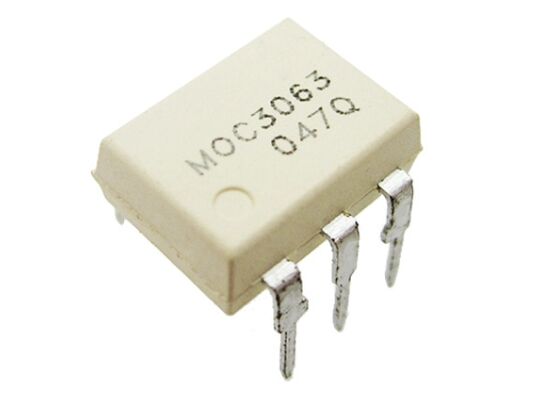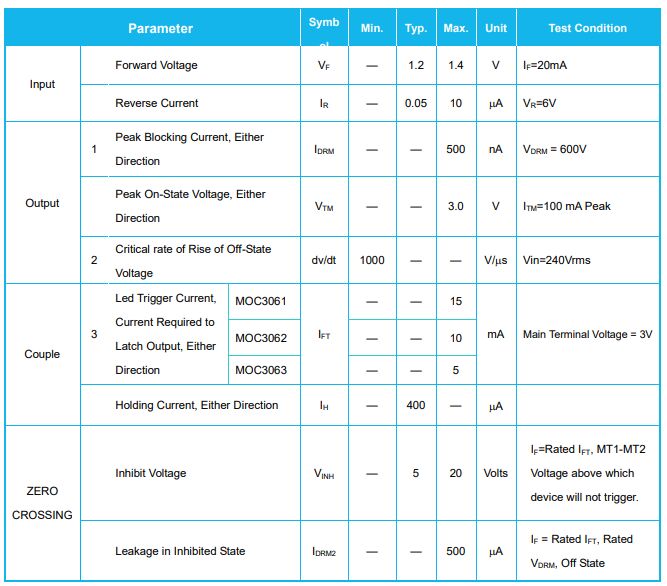By Lite-On 200
MOC3063 is a type of optocoupler, also known as opto-isolator. An optocoupler is a device that can pass electrical signals between an input and output while providing electrical isolation through optical means. The MOC3063 is commonly used to isolate and control AC equipment. It contains an optocoupler isolator and a three-terminal thyristor (TRIAC) output. TRIAC is a bidirectional controllable switch for AC loads, which can be used to switch, dim and control AC equipment.
The design of MOC3063 is based on the principle of photoelectric isolation, which isolates the input and output circuits through an internal optocoupler. This isolation helps prevent electrical noise or high voltage at the input from affecting the output, improving the stability and safety of the circuit.

Ⅰ.Specifications of MOC3063
•Installation style:Through Hole
•Package/Case:PDIP-6
•Output type:PhotoTriac
•Zero-Crossing Circuit:With Zero-Crossing Circuit
•Number of channels:1 Channel
•Insulation voltage:5000 Vrms
•Output type:PhotoTriac
•Voltage-Off state:600 V
•Static dV/dt (minimum):1kV/µs
•Current-LED trigger (Ift) (maximum):5mA
•Forward voltage (Max):1.4 V
•Forward current (Max):50mA
•If-forward current:50 mA
•Vf-forward voltage:1.2 V
•Pd-Power dissipation:250 mW
•Minimum operating temperature:-40℃
•Maximum operating temperature:+100℃
•Height:3.5 mm
•Length:7.3 mm
•Maximum trigger current:5 mA
•Maximum on time:20 us
•Zero cross voltage:20V
Ⅱ.Functions of MOC3063
1.Optical input: The input terminal accepts optical signals, and changes in the optical signal will affect the TRIAC trigger at the output terminal. Typically, the MOC3063 provides light signals through an external light source (such as a light-emitting diode).
2.TRIAC output: The output terminal is a three-terminal thyristor (TRIAC). TRIAC is a bidirectional controllable switch suitable for controlling AC loads. By triggering TRIAC, AC equipment can be switched, dimmed and controlled.
3.Optoelectric isolation: MOC3063 achieves electrical isolation between the input terminal and the output terminal through an internal optical coupler. This isolation helps prevent electrical noise, high voltage, or other interference at the input from adversely affecting the output.
4.AC load control: MOC3063 is usually used to control AC loads, such as light bulbs, heaters, motors, etc. Precise control of these loads can be achieved through optical isolation and TRIAC control.
5.Electrical isolation: MOC3063 is designed to provide a high degree of electrical isolation to ensure that the signals passed between the input and output do not interfere with each other or cause safety hazards.
6.Trigger control: MOC3063 allows the TRIAC associated with it to be controlled through the optical signal at the input end, thereby achieving precise triggering and control of the AC load.
Ⅲ.Characteristics of MOC3063
1.High voltage isolation: MOC3063 has a voltage isolation capability of up to 7500Vrms, which can effectively isolate input and output circuits and provide safe and reliable power control.
2.Zero-voltage AC switch: MOC3063 adopts zero-voltage AC switching technology, which can perform switching operations at the zero point of the AC voltage, reducing the current impact during switching and improving the stability and reliability of the system.
3.High-speed switching: MOC3063 has a transmission rate of up to 5Mbps, which can achieve fast switching operations and improve the response speed of the system.
4.Wide operating temperature range: The operating temperature range of MOC3063 is -40℃ to 85℃, which can adapt to various harsh working environments.
5.Bidirectional operation: MOC3063 can realize bidirectional operation of input and output at the same time, suitable for applications that require bidirectional signal transmission between two circuits.
IV.Pin functions of MOC3063

•Pin 1 (Anode): This is the anode of the LED of the optocoupler. By connecting to this pin and driving current through the LED, a light signal can be generated that affects the output of the opto-isolator.
•Pin 2 (Cathode): This is the cathode of the LED of the optocoupler. It is connected to the cathode of the LED, forming the LED's current loop.
•Pin 3 (VCC): This is the power supply pin used to connect the input side power supply. Typically, it is connected to the appropriate supply voltage to ensure the LED gets the proper drive current.
•Pin 4 (GND): This is the ground pin, used to share the ground with the input side power supply.
•Pin 5 (MT1): This is the main terminal 1 on the output side. It is connected to the control terminal of the three-terminal thyristor (TRIAC). ,
•Pin 6 (GATE): This is the control terminal (GATE) of the TRIAC on the output side. By applying the appropriate voltage to this pin, the load connected to the MT1 pin can be triggered and controlled.
•Pin 7 (MT2): This is the main terminal 2 on the output side. It is connected to the AC power source of the load.
Ⅴ.Absolute Maximum Ratings of MOC3063

Ⅵ.Electrical Optical Characteristics of MOC3063

1.Test voltage must be applied within dv/dt rating.
2.This is static dv/dt, Commutating dv/dt is a function of the load driving thyristor(s) only.
3.All devices are guaranteed to trigger at an lF value less than or equal to max lFT. Therefore, recommended operating lF lies between max lFT, 15mA for MOC3061, 10 mA for MOC3062, 5 mA for MOC3063, and absolute max lF(50mA ).
Ⅶ.Optoelectric isolation performance of MOC3063
1.Isolation Voltage: The isolation voltage indicates the maximum voltage that the device can safely isolate. It is the maximum voltage difference between the input and output terminals.
2.Leakage Current: Leakage current refers to the current passing through the device in isolation. Lower leakage current indicates better isolation performance.
3.Dielectric Strength: Withstand voltage refers to the electric field strength that the device can withstand under specific test conditions. Usually expressed in Vrms (root mean square voltage).
4.Transient Overvoltage Capability): Refers to the device's ability to withstand a surge (such as a transient overvoltage caused by external interference or fault) at the input or output end.
5.Spectral response: The operation of optoelectronic isolation devices depends on the transmission of light. Therefore, the photoelectric isolation performance is also related to its response range and sensitivity to optical signals.
Ⅷ.Replacement model of MOC3063
1.MOC3023: Similar to MOC3063, with photoelectric isolation and TRIAC output, but the specific specifications may be different.
2.MOC3021: This is an earlier version of the MOC3063 series and is also a common optocoupler model. It serves a similar purpose but may have different technical specifications.
3.MOC3081: This is another optocoupler model to consider, with optical isolation and TRIAC output.
4.PC817: This is another common optocoupler model that is widely used in power supply and control circuits. Although it may not have a TRIAC output, it may be an alternative in some applications.
Frequently Asked Questions
1.What is MOC3063 used for?
MOC3063 is commonly used as an optocoupler or opto-isolator. It provides electrical isolation between input and output, making it suitable for applications where isolation is necessary.
2.What is the TRIAC output used for in MOC3063?
The TRIAC output in MOC3063 is used to control AC loads. It allows for switching and, in some cases, dimming of AC devices like lights or motors.
3.Is MOC3063 suitable for high-voltage applications?
MOC3063 is designed for moderate voltage applications. The suitability for high-voltage applications depends on the specific requirements of the application and the electrical specifications of MOC3063.
4.How does MOC3063 achieve electrical isolation?
MOC3063 achieves electrical isolation by using an optically coupled interface. The input side has an LED, and the output side has a TRIAC. The control signal is transmitted optically, preventing electrical contact between the input and output.